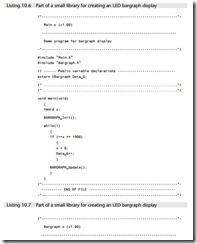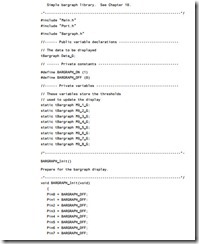Port header
Context
● You are developing an embedded application using one or more members of the 8051 family of microcontrollers.
Problem
How do you manage port access allocations in a larger project?
Background
In a typical embedded project, you may have a user interface created using an LCD, a keypad and one or more single LEDs. There may be a serial (RS-485) link to another microcontroller board. There may be one or more high-power devices (say three- phase industrial motors) controlled by your application.
Each of these (software) components in your application will require exclusive access to one or more port pins. The project may include 10–20 different source files. How do you ensure that changes to port access in one component do not impact on another? How do you ensure that it is easy to port the application to an environment where different port pins must be used?
These issues are addressed through the simple PORT HEADER design pattern.
Solution
P ORT H EADER encapsulates a simple but effective design guideline that can help you cope with the fact that many different components in a larger project will each require port access: specifically, using P ORT H EADER , you will pull together the differ- ent port access features for the whole project into a single (header) file. Use of this technique can ease project development, maintenance and porting.
Port Header is simple to understand and simple to apply.
Consider, for example, that we have three C files in a project (A, B, C), each of which requires access to one or more port pins, or to a complete port.
In this version of the code, all of the port access requirements are spread over mul- tiple files. Instead of this, there are many advantages obtained by integrating all port access in a single Port.H header file:
Listing 10.4 An example of a real Port Headerfile (Port.H) from a project using an interface consisting of a keypad and liquid crystal display
Hardware resource implications
There are no hardware resource implications.
Reliability and safety implications
Despite its simplicity, Port Header can improve reliability and safety, because it avoids potential conflicts between port pins, particularly during the maintenance phase of the project when developers (who may not have been involved in the original design) are required to make code changes.
Portability
Port Header is itself portable: it can be used with any microcontroller and is not linked to the 8051 family. Use of Port Header also improves portability, by making accessible in one location all the port access requirements of the application.
Overall strengths and weaknesses
PORT HEADER is both simple and effective – use it!
Related patterns and alternative solutions
See PROJECT HEADER [page 169].
Example: LED bargraph display
Suppose we wish to test an application involving an analog-to-digital converter. Specifically we want to display the voltage reading on a set of 8 LEDs connected to Port 1 of our 8051 device (Figure 10.2).
The key software files required to create this application follow (Listings 10.5 to 10.8): a complete set of the source files for the project is included on the CD.








